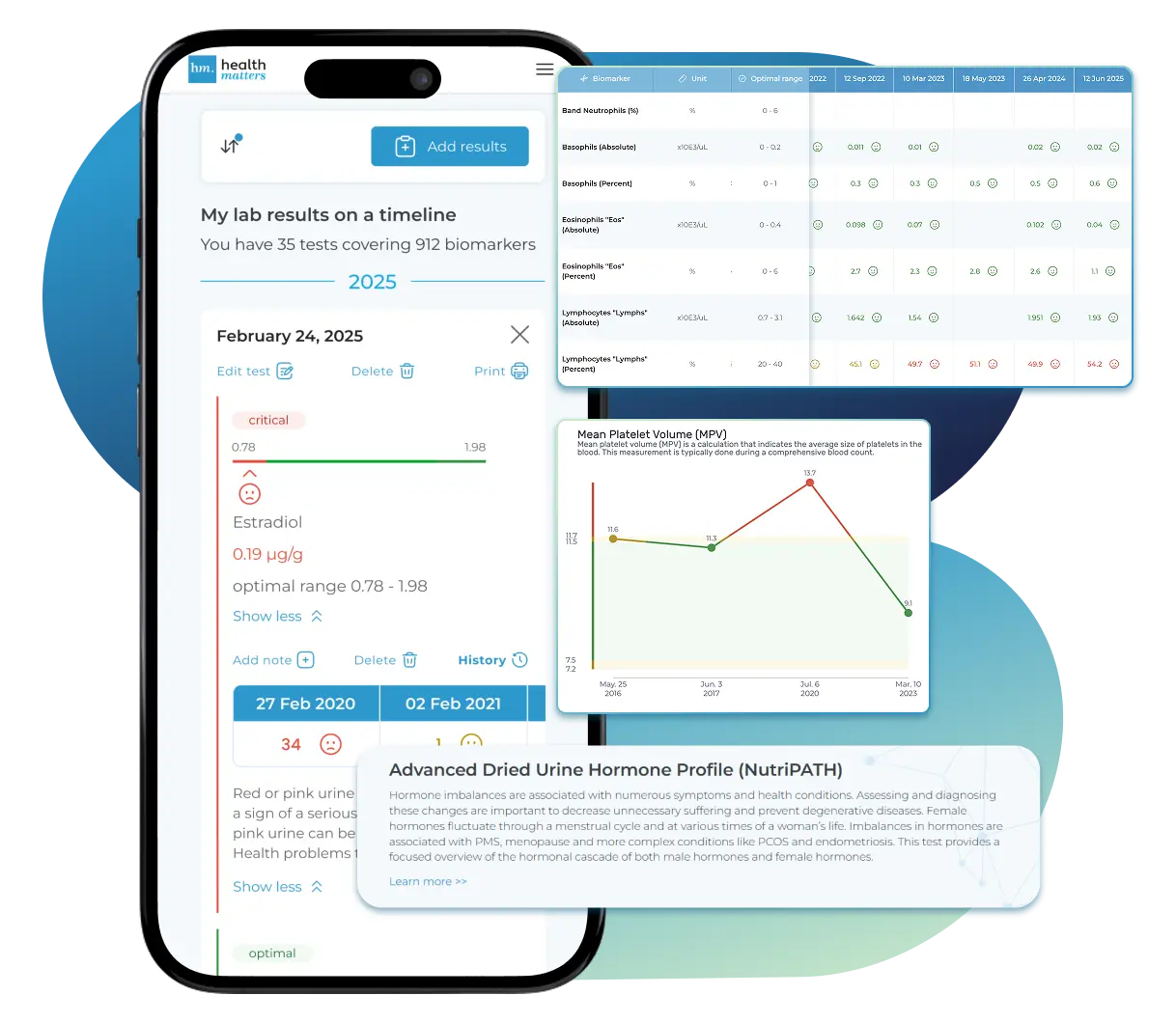Other names: G-6-PD, Quant
Glucose 6-Phosphate Dehydrogenase, often abbreviated as G6PD (or G-6-PD), plays a critical role in the body's cellular function. This enzyme is vital for the health of all cells, but it's particularly crucial for red blood cells.
G6PD helps cells manage oxidative stress. Oxidative stress occurs when there's an imbalance between the production of harmful free radicals (unstable molecules that can damage cells) and the body's ability to counteract their harmful effects through neutralization with antioxidants. G6PD aids in the production of NADPH, a molecule that plays a key role in the antioxidant defense system of cells. Specifically, NADPH helps maintain the supply of glutathione, a powerful antioxidant that protects red blood cells from damage.
The importance of G6PD comes into the spotlight when we consider its role in maintaining the integrity and functionality of red blood cells. These cells are responsible for transporting oxygen from the lungs to the rest of the body and returning carbon dioxide back to the lungs for exhalation. Because red blood cells are continuously exposed to oxygen, they are particularly susceptible to oxidative damage. G6PD ensures that red blood cells can protect themselves against such damage and thus, maintain their crucial function in oxygen transportation.
However, when there's a deficiency in G6PD, red blood cells are more vulnerable to oxidative stress, leading to a condition known as hemolytic anemia. In hemolytic anemia, red blood cells are destroyed faster than they can be made, resulting in fatigue, jaundice (a yellowing of the skin and eyes), and other symptoms due to the lack of adequate oxygen delivery to the body's tissues. This condition can be triggered by various factors, including certain foods, infections, and medications that increase oxidative stress within red blood cells.
A G6PD test, specifically a quantitative test, measures the exact amount of the enzyme present in the blood. This test is crucial for diagnosing G6PD deficiency. Knowing the precise levels of G6PD helps healthcare providers manage and advise patients with the deficiency on how to avoid triggers that may lead to hemolytic anemia. It's particularly important in regions where G6PD deficiency is common or for individuals of certain ethnic backgrounds that have a higher prevalence of this condition.
Understanding G6PD and its significance requires a look at both the cellular level, where it helps protect cells from oxidative damage, and the broader impacts, such as its role in preventing hemolytic anemia. Through the quantitative measurement of G6PD, healthcare providers can better diagnose, manage, and provide guidance to those affected by G6PD deficiency, improving their quality of life and preventing potential complications.
High levels of Glucose 6-Phosphate Dehydrogenase (G6PD) in the blood are quite unusual and typically do not indicate a specific health problem. In fact, the primary concern with G6PD usually revolves around having too little of it rather than too much. G6PD deficiency, where levels of the enzyme are lower than normal, can lead to problems like hemolytic anemia. However, if a test shows high levels of G6PD, it's often not considered clinically significant in the same way a deficiency is. That said, in rare cases, elevated G6PD levels might be seen in individuals who have an increased production of red blood cells or in certain recovery phases after a bout of hemolytic anemia, where the body is compensating by producing more red blood cells, some of which might be young cells (reticulocytes) with higher enzyme levels. Nevertheless, the interpretation of high G6PD levels should be considered within the context of the patient's overall health, symptoms, and medical history. It's important to remember that the enzyme's primary role is to protect cells from damage caused by oxidative stress, and the focus in G6PD discussions typically centers on the risks associated with not having enough of this protective enzyme.

Import lab results from multiple providers, track changes over time, customize your reference ranges, and get clear explanations for each result. Everything is stored securely, exportable in one organized file, and shareable with your doctor—or anyone you choose.
Cancel or upgrade anytime

Low levels of Glucose 6-Phosphate Dehydrogenase (G6PD) signify a deficiency in this crucial enzyme, which can lead to a condition known as G6PD deficiency. This condition is particularly significant because G6PD plays a vital role in helping red blood cells protect themselves against oxidative damage—harm caused by free radicals, which are unstable molecules that can damage cells. Red blood cells carry oxygen throughout the body, and without enough G6PD, these cells are more vulnerable to breaking down when faced with oxidative stress. This breakdown can lead to hemolytic anemia, a state where the body doesn't have enough red blood cells to transport oxygen effectively, causing symptoms like fatigue, weakness, shortness of breath, and a yellowing of the skin and eyes known as jaundice. The triggers for this oxidative stress can be varied, including certain foods (like fava beans), infections, and some medications. Therefore, low G6PD levels are a signal that the body may not be adequately equipped to handle these oxidative challenges, leading to potential health issues that stem from the inability of red blood cells to function properly.
Does a low G6PD level mean that I have a G6PD deficiency?
Not necessarily, but a low G6PD level is a strong indicator of G6PD deficiency. The G6PD test measures the activity of the glucose-6-phosphate dehydrogenase enzyme in your blood. Typically, levels below the normal range suggest that your body may not be producing enough of the enzyme, which is the hallmark of G6PD deficiency. However, various factors can influence test results, including the testing methodology, your health status at the time of the test, and laboratory variations.
It's also important to consider that G6PD levels can fluctuate in the body, especially during or after an episode of illness, infection, or exposure to oxidative stress. Moreover, certain populations may have genetic variants of the enzyme that could affect the test's interpretation.
If your G6PD levels are found to be low, a healthcare professional would likely consider your clinical history, signs, and symptoms, along with possibly repeating the test or performing additional tests, before definitively diagnosing you with G6PD deficiency. It's a condition with a genetic basis, so a comprehensive evaluation including family history and genetic testing might be necessary for a conclusive diagnosis.
What are treatment options?
Treatment options for G6PD deficiency mainly focus on avoiding triggers that lead to oxidative stress in red blood cells, as there is no cure for the deficiency itself. This preventive approach includes steering clear of certain foods, like fava beans and other legumes, and certain drugs that can exacerbate the condition, such as certain antibiotics, aspirin, and quinine. People with G6PD deficiency should also be cautious about exposure to infections and chemicals that could trigger hemolysis (the breakdown of red blood cells). In cases where hemolytic anemia occurs, treatment might involve supportive care, such as hydration and rest, and in more severe cases, hospitalization may be necessary to provide oxygen therapy, blood transfusions, or other treatments to manage symptoms and complications. It's crucial for individuals with G6PD deficiency to have ongoing consultations with healthcare providers who can offer personalized advice and monitor their health to prevent and manage potential complications. Awareness and education about the condition are key, as understanding the triggers can significantly reduce the risk of hemolytic episodes and improve quality of life.
Laboratories
We accept reports from any lab, so you can easily collect and organize all your health information in one secure spot.











Pricing Table
Choose the plan that fits you — and turn scattered lab reports into clear insights you can finally use.
Pick a plan that fits you — and turn scattered lab reports into clarity.
Personal plans
Professional plan
$15/ month
Access your lab reports, explanations, and tracking tools.
$250/ once
Pay once, access everything—no monthly fees, no limits.
Professional plan
$45/ month
Designed for professionals managing their clients' lab reports
About membership
 Import Lab Results from Any Source
Import Lab Results from Any Source
Easily upload lab results from any provider, whether it's a hospital, independent lab, or home testing service. We support PDFs, scanned documents, and JPEGs from patient portals. No need to log in to multiple platforms — everything is centralized in one secure space.
Easily upload lab results from any provider — we support PDFs, scans, and images. Keep all your reports organized in one secure place.
 See Your Health Timeline
See Your Health Timeline
Every lab result is automatically organized on a chronological timeline, giving you a complete picture of your health journey. Whether you're tracking a condition, managing treatments, or staying proactive, the timeline helps you and your doctor understand how things progress over time.
Every lab result is automatically organized on a chronological timeline, giving you a complete picture of your health journey.
 Understand What Your Results Mean
Understand What Your Results Mean
Whether it's a blood test, GI panel, urinalysis, or something else, lab reports measure numerous biomarkers that reveal what's happening inside your body. Our extensive database covers over 10,000 biomarkers, providing clear, simple explanations of what each result means and how you can take action—no matter your membership level. Say goodbye to confusion and get the insights you need to better understand your health.
Our database covers over 10,000 biomarkers with clear, simple explanations—so you can finally understand your results and what to do next.
 Enter Your Lab Reports Yourself — Always Free
Enter Your Lab Reports — Always Free
Enter Your Lab Reports Yourself — Always Free
Enter Your Lab Reports — Always Free
If you'd like to handle inputting your health data into your account, you can do so with our easy-to-use data entry forms. Our user-friendly form is designed to guide you through the quick and easy submission process, making it simple to keep track of your health metrics. This is available to both Complete plan and Unlimited plan members.
Our user-friendly form guides you through a quick, simple submission process, making it easy to enter your health metrics.
Add your results anytime with our easy entry form. It's quick, guided, and helps you stay organized — free for all members.
 Visualize Your Results
Visualize Your Results
View your lab data through easy-to-read graphs and tables. Quickly spot patterns, track changes, and compare results across different dates — all without digging through multiple reports. You can also select and compare graphs of specific biomarkers side-by-side to better understand how they relate and change over time.
See your lab reports in clear graphs and tables. Spot patterns, track changes, and compare results over time — all in one place.
 Export Your Complete Lab History in a Single File
Export Your Complete Lab History
Export Your Complete Lab History in a Single File
Export Your Complete Lab History
After collecting lab results from different providers, you can download your entire history combined into a single file. Choose from PDF, Excel, or CSV formats to easily review, share, or get a second opinion—no more juggling multiple reports.
After collecting lab results from different providers, you can download your entire history combined into a single file.
 Comprehensive Data Entry Service for Your Reports
Data Entry Service for Your Reports
Comprehensive Data Entry Service for Your Reports
Data Entry Service for Your Reports
Our inclusive service handles the data entry for your lab reports. Just submit your information and we'll take care of the rest. Complete plan members receive one report entered for free, then $15 per report after that. Unlimited plan members receive ten report entries for free, then $15 per report after that.
Our inclusive service handles the data entry for your lab reports. Just submit your information and we'll take care of the rest.
 Securely Share With Anyone You Trust
Securely Share With Anyone You Trust
Whether you're working with a doctor, nutritionist, caregiver, or wellness coach, you can securely share your complete lab history by sending an invite link to anyone you trust. You have full control over who sees your information and for how long, ensuring your privacy and peace of mind at every step.
Share your full lab history with your doctor, nutritionist, or coach using a secure invite link.
Discover






I have been using Healthmatters.io since 2021. I travel all over the world and use different doctors and health facilities. This site has allowed me to consolidate all my various test results over 14 years in one place. And every doctor that I show this to has been impressed. Because with any health professional I talk to, I can pull up historical results in seconds. It is invaluable. Even going back to the same doctor, they usually do not have the historical results from their facility in a graph format. That has been very helpful.
Anthony
Unlimited Plan Member since 2021

What fantastic service and great, easy-to-follow layouts! I love your website; it makes it so helpful to see patterns in my health data. It's truly a pleasure to use. I only wish the NHS was as organized and quick as Healthmatters.io. You've set a new standard for health tracking!
Karin
Advanced Plan Member since 2020

As a PRO member and medical practitioner, Healthmatters.io has been an invaluable tool for tracking my clients' data. The layout is intuitive, making it easy to monitor trends and spot patterns over time. The ability to customize reports and charts helps me present information clearly to my clients, improving communication and outcomes. It's streamlined my workflow, saving me time and providing insights at a glance. Highly recommended for any practitioner looking for a comprehensive and user-friendly solution to track patient labs!
Paul
Healthmatters Pro Member since 2024
Healthmatters is a personal health dashboard that helps you organize and understand your lab results. It collects and displays your medical test data from any lab in one secure, easy-to-use platform.
With a Healthmatters account, you can:
Professionals can also analyze client data more efficiently and save time managing lab reports.
Healthmatters.io personal account provides in-depth research on 4000+ biomarkers, including information and suggestions for test panels such as, but not limited to:
You can combine all test reports inside your Healthmatters account and keep them in one place. It gives you an excellent overview of all your health data. Once you retest, you can add new results and compare them.
If you are still determining whether Healthmatters support your lab results, the rule is that if you can test it, you can upload it to Healthmatters.
While we work with many popular labs, we welcome reports from lots of other places too.
It's as simple as this: if you can get a test done, you can upload it to Healthmatters and we can interpret results from any lab out there. If laboratories can analyze it, we can interpret it.
If you're on the hunt for a specific biomarker, contact us and we'll add it to our database. Anything from blood, urine, saliva, or stool can be uploaded, understood, and tracked with your Healthmatters account.
The Complete Plan ($15/month) is perfect for individuals who want ongoing access to their health data. It includes unlimited lab imports, visual tracking, custom ranges, result explanations, full account exports, and secure sharing — all with a simple monthly subscription. You can cancel anytime and restart your plan whenever you're ready — your data will still be there waiting for you. You can also upgrade to the Unlimited Plan at any time, with the cost prorated based on what you've already paid.
The Unlimited Plan ($250 one-time) is also designed for individuals but offers lifetime access with no ongoing subscription. You'll get all the same features as the Complete Plan, plus a larger initial data entry allowance (10 reports), making it a great choice if you prefer a one-time payment and long-term use without monthly fees.
In short:
There are two ways to add your test reports to your Healthmatters account. One option is to input the data using the data entry forms. The other method is to utilize our "Data entry service."
Our data entry forms offer an easy, fast, and free way for you to input the reports yourself. Self-entry allows you to add an unlimited number of reports at no cost. We make the self-entry process user-friendly, providing dozens of templates that pre-populate the most popular laboratory panels and offering instant feedback on entered values.
For those who prefer assistance, we offer a "Data entry service" to help you input your data. Simply attach an image or file of your lab test results, and a qualified team member from our data entry team will add the results for you.
We support various file types, including PDFs, JPGs, or Excel. This service is particularly useful if you have many reports to upload or if you're too busy to handle the data entry yourself.
Our Data Entry Service is for when you don't want to manually type in your lab results yourself. You simply upload your report (PDF, image, or screenshot), and our trained team enters the information into your Healthmatters account for you — accurately and neatly organized, ready to view in graphs, tables, and timelines.
The $15 per report covers the time and care it takes for a real person to review your file, make sure each result is entered correctly, and double-check for accuracy. This ensures your health data is precise and easy to work with — without you having to spend the time doing it yourself.
Prefer to do it yourself? You can always use our free self-entry tool to add results manually — it just takes a bit more time and attention.
For users on the Complete monthly plan, the first report is entered free of charge, and each additional report incurs a fee of $15.
Unlimited account holders enjoy the entry of ten reports without charge. Subsequent reports are subject to a $15 fee per report.
Additionally, users on the Complete plan can upgrade to a yearly subscription from the account settings. The annual subscription includes a data entry service for five reports.
All professional accounts allow you to import and onboard an unlimited number of clients and their lab results. The distinction between professional plans lies solely in the data entry service.
The Pro Monthly Plus plan is priced at $75 per month and includes a data entry service for five reports each month. Additional reports can be self-entered at no extra cost or, if preferred, you can use our data entry service for an additional fee of $15 per report.
The Pro Monthly plan is priced at $45 per month and does not include a data entry service. Self-entry is free for an unlimited number of reports, and you can opt for the data entry service at a fee of $15 per report.
You also have the option to upgrade to higher monthly or to annual plans, which come with substantial discounts. All upgrades can be done directly from your account.
Simply log in and navigate to your account settings to cancel your subscription. Scroll down to locate the 'Cancel' button at the bottom of the page. Ensure you cancel at least one day before the renewal date to prevent any charges. Once cancellation is requested, the subscription remains active until the conclusion of the current billing cycle.
Our goal has been to make your Healthmatters account as intuitive as possible.
We've crafted multiple ways for you to navigate your data, whether you're glancing at a single report or delving into your historical test reports.
1. Graph View:Dive into a visual journey with our biomarker graphs, showcasing over 40 data points. Combining years of results unveils trends, empowering you to make informed decisions. Our visualization tools make it a breeze to compare and understand changes over time, even if your results are from different labs. A search function and filters simplify the exploration of extensive data, allowing you to focus on what needs attention.
2. All Tests ViewExplore neatly organized reports on a timeline, highlighting crucial details like dates, critical results, and lab/panel names. Each report opens up to reveal in-depth descriptions and additional recommendations for each biomarker. The history of previous results is just a click away, and you can download a comprehensive report for deeper insights. Color-coded and user-friendly, it's designed for easy reading, understanding, and navigation.
3. Table View:For a holistic view of all biomarkers side by side, our table view is your go-to. Results are neatly displayed in a categorized and dated table, ideal for those with an extensive test history. Utilize sorting, filters, and color-coding to enhance your analysis and gain extra insights.
Yes, you can download your information anytime. We offer two easy ways to export your lab data:
This makes it simple to save, back up, or share your health data whenever you need.
Yes, you can print your report. To do so, navigate to "All tests" and open the report you wish to print. You'll find a print button in the right corner of the report. Click on it, and your browser's print window will open. If you prefer to print in a bigger typeface, adjust the scale using the print window settings.
Yes, you can! We highly recommend activating Two-Factor Authentication (2FA) for your account. To do so, please navigate to the "Profile and Security" section of your account, where you will find instructions for activating 2FA.
Yes, you can. When entering values for the biomarker, you will see an "Edit Range" button. Click this button, and you'll have the option to enter a custom range.
A personal account is all about keeping your own lab test results in check. It's just for you and your personal use.
The professional account is designed for health professionals who wish to track and organize their clients' laboratory results.
To learn more about Healthmatters Pro, please refer to the professional page.
At HealthMatters, we're committed to maintaining the security and confidentiality of your personal information. We've put industry-leading security standards in place to help protect against the loss, misuse, or alteration of the information under our control. We use procedural, physical, and electronic security methods designed to prevent unauthorized people from getting access to this information. Our internal code of conduct adds additional privacy protection. All data is backed up multiple times a day and encrypted using SSL certificates. See our Privacy Policy for more details.

